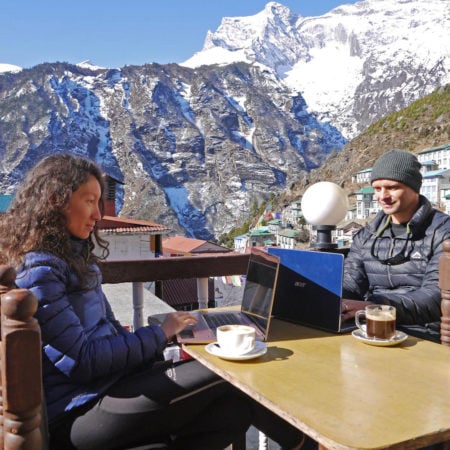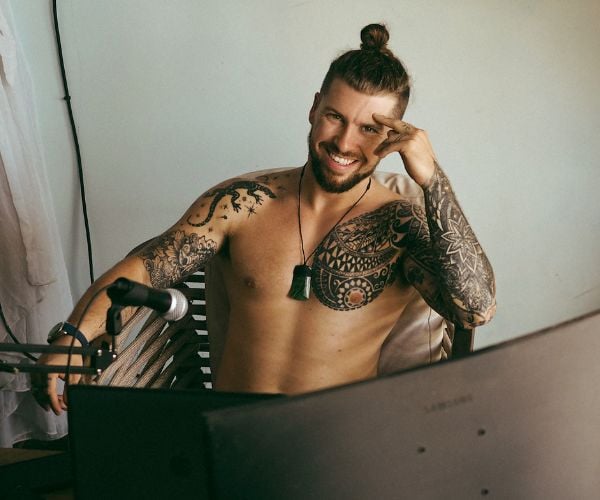The Broke Backpacker is supported by you. Clicking through our links may earn us a small affiliate commission, and that's what allows us to keep producing free content 🙂 Learn more.
The southern end of South America, shared by Argentina and Chile is known as Patagonia. Here the impressive Andes mountains crowned with glaciers, waterfalls, glacial lakes and marshlands is home to some of the most beautiful scenery in the world.
Hiking in Patagonia is an amazing experience. We traveled around the area for 2 months doing some spectacular trekking, including the famous Torres Del Paine hiking trail.
The Argentine side is mostly called ‘pampa’ it is arid landscapes featuring steppes, grasslands and deserts, while the Chilean has glacial fjords and temperate rainforest. Patagonia has a well-worn tourist trail; unfortunately, it is well-known to be very expensive.
If you stay in hostels and get around by bus your budget for Patagonia will be around $50 per day. Our budget for traveling in Patagonia was only about $15 per day! The secret? Camping, hitchhiking and cooking for ourselves. Since accommodation and transport are super expensive, cutting on these make it very affordable.
Our other big money saver was a bonus, hiking, this is main adventure activity in the region. We did a couple of hikes and did all of them independent. Since entrance fees are low, you cannot carry that much stuff with you and you don’t spend money on the route, hiking was a big money saver.
During our 2 months hitchhiking adventure crossing Patagonia, we did many spectacular hikes. Following each hike, we stayed in a campsite for a couple of days recharging before hitting the road, moving a dedo (hitchhiking) towards the start of our next trek.
From North to South: Our Favorite hiking trails in Patagonia
Pumalin Park (Chile)
Pumalin Park was our first stop for hiking while hitchhiking south on the Carretera Austral. This beautiful park is the biggest private park in the world with amazing views, rivers, glaciers and waterfalls. Pumalin park belonged to the American adventurist and billionaire, Douglas Tompkins, owner of gear company ‘The North Face’. Douglas died in Patagonia when his kayak fell over into the freezing water.
The park doesn’t have any multi day hikes but there are several one-day hikes of varying lengths and difficulty that you can explore. There are a couple of campsites in the park; we recommend that you stay at the campsite closest to the route that you are planning to hike.
We camped in the park for 5 days and did several hikes. The Cascades (trail) was awesome, it takes about 4 hours and leads through dense forest, along the river and ending with an impressive huge waterfall. The longest hike in the park is Volcano Michinmahuida, a 24km trail (return) starting at Carol Urzúa bridge, 28,5 km south of Caleta Gonzalo, this hike takes between 8-10 hours.
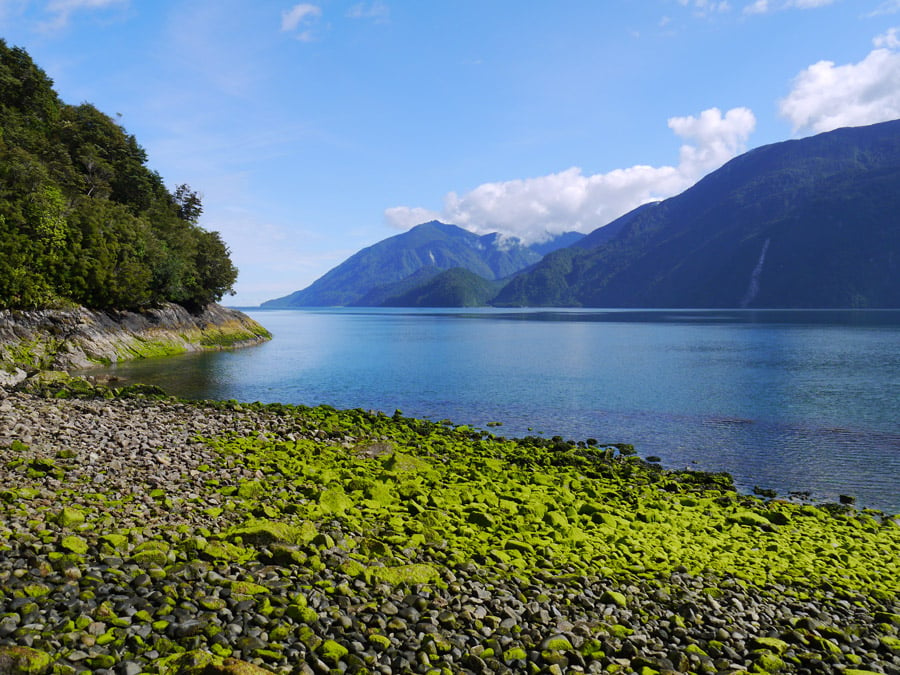
The Broke Backpacker is supported by you. Clicking through our links may earn us a small affiliate commission, and that's what allows us to keep producing free content 🙂 Learn more.
Leaving Pumalin Park at the southern exit we hitchhiked for several days before starting the next trek. There are several nice hikes and towns on the Carretera Austral, we really enjoyed the one day hikes in National Park Quelat.
Heading south Alya lost her backpack! it fell from a truck that gave us a ride. She lost all her clothes and toiletries, we shared a sleeping bag for the next 2 months!
Cerro Castillo (Chile)
The Cerro Castillo Circuit located on the beautiful Cerro Castillo Reserve has incredible scenery, hanging glaciers, crystal clear rivers, ice cold lakes, huge pine forests and bizarre shaped mountains. There are different routes varying between 1 and 4 days in length to explore the park; we did the 4-day route and it was amazing! This is some of the most popular trekking routes in Patagonia with good reason.
The hike starts at Valle de la Lima, it is 30km before Villa Cerro Castillo driving from Coyhaique. The trek is about 45km long with some ups and downs, the path is very clear and easy to follow and the scenery is spectacular. There are free campsites in the park and you can drink from rivers, lakes, waterfalls all over the park. The park was not nearly as touristy as Torres Del Paine or El Chalten.
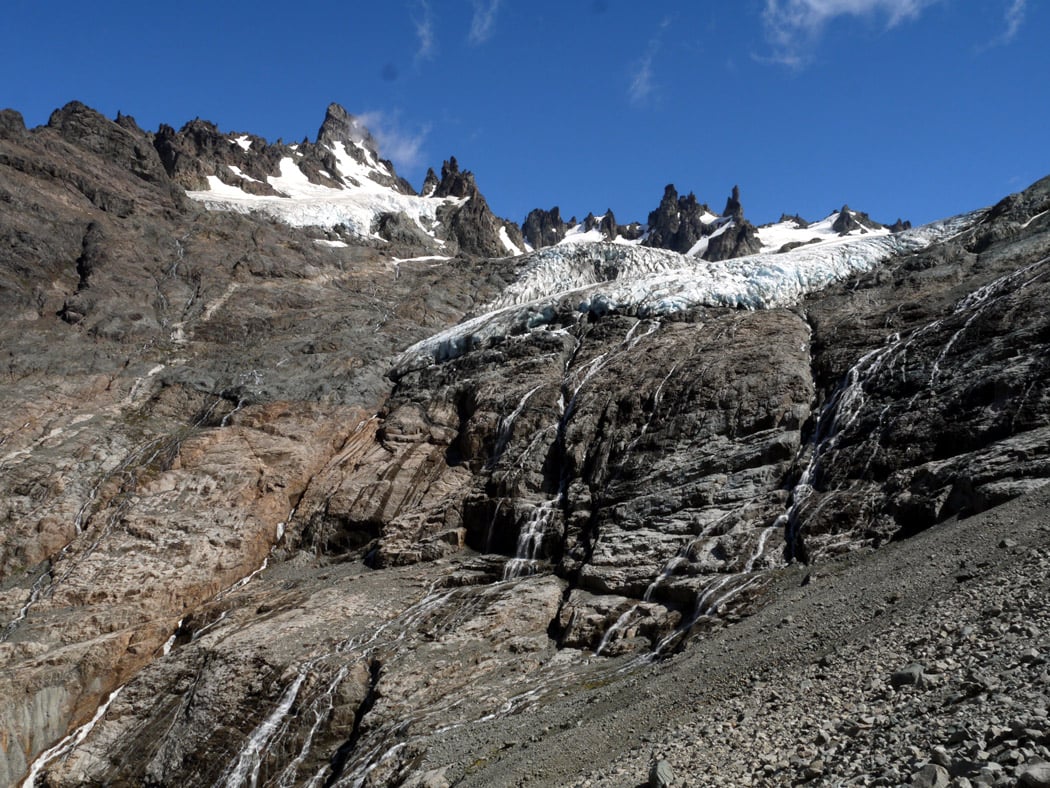
O’Higgins Glacier Hike – really getting off the beaten track
We took a couple of days to get from Cerro Castillo to O’Higgins. To get from O’Higgins to El Chalten over the Chile/Argentina border was a very interesting mission walking about 60km, a lot of it with all our stuff, not only hiking packs but laptops, big cameras etc.
When we got off the ferry at Candelario Mancilla we signed up for the hike and left our extra luggage at the Chilean customs office from where we started our hike to the glacier.
If you like to hike unknown areas with no other people both O’Higgins and El Chico glacier are perfect. Prepare yourself for amazing views of, glaciers, mountains, and forest surrounding the O’Higgins Lake.
Even more to have all of it for yourself not seeing any other hikers and being free to camp, walk and stop wherever you want.
Cold and windy weather conditions, a badly marked path and the remote location make this hike tough at times. It can be easily combined (we did it) with walking from O’Higgins to El Chalten, just bring enough food since there is nowhere to buy food on the way.
The hike took 4 days to get to the glaciers and back to the customs office to collect our luggage. We walked about 9 hours a day in all seasons of weather: pouring rain, stormy wind, hail, sun and snow. It was an awesome adventure!
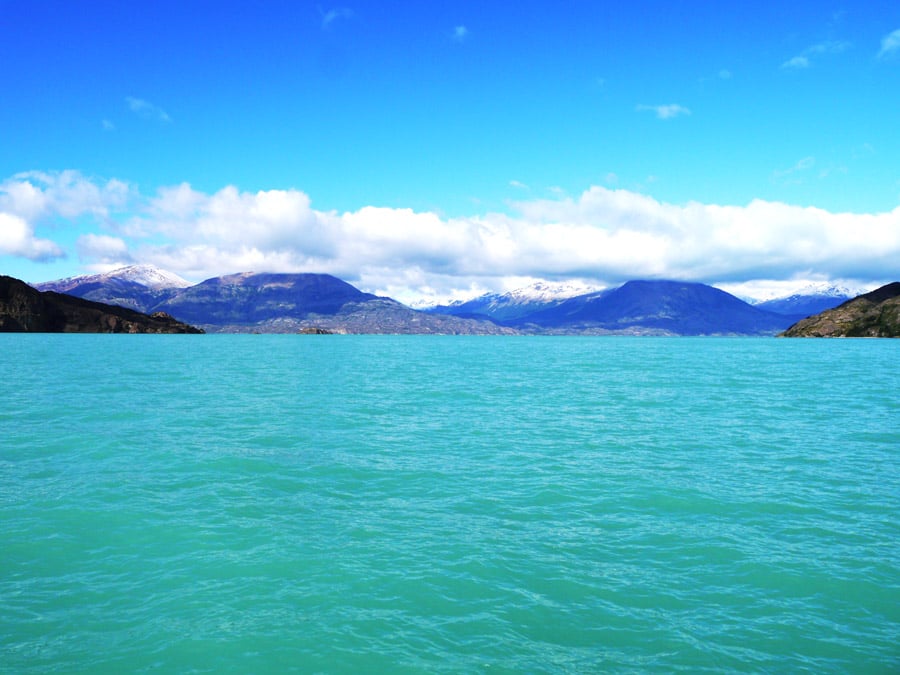
El Chalten (Argentina)
El Chalten is considered the hiking capital of Patagonia by many. There are some incredible sites in the park. Cerro Fitz Roy and Cerro Torres are two views you do not want to miss while camping and trekking here.
In the park several trails lead to the main viewpoints, each taking between four and eleven hours to hike from the town. The trails are well marked and free maps are available all over the town. Eventually, you can combine several trails to make up a hike to suit your needs. There are four free campsites in the park. El Chalten is not ‘off the beaten track’ place for wild adventurous hiking, but the views are spectacular and we enjoyed hiking here.
In El Chalten, bus prices were crazy high forcing many budget travellers to try hitchhiking for the first time. The next stop on the backpacker trail is Perito Merino glacier at El Calafate.
We saw quite a few backpackers walk into the bus station only to come and stand next to the road a couple of minutes later with a painful expression hoping for a lift. It was a long day next to the road with more than 20 of us competing for rides!
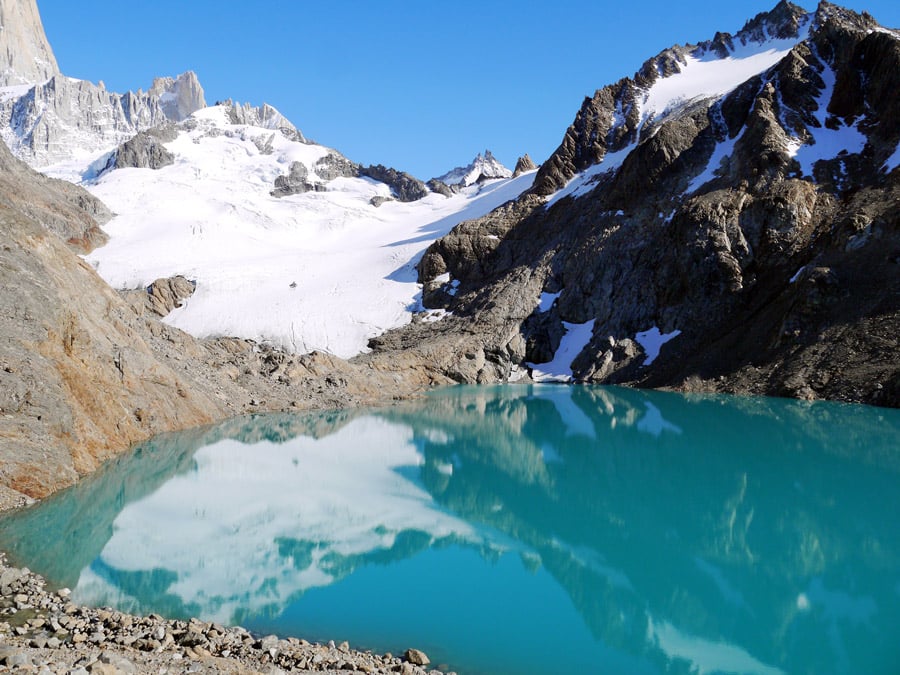
Torres Del Paine (Chile)
Keep heading south and back in Chile Torres Del Paine is the most famous hike in Patagonia for good reason; it was definitely one of the most spectacular hikes we have ever done. There are 3 main routes that you can hike to experience the soaring mountains, bright blue icebergs, fantastic glaciers and golden pampas of Torres Del Paine.
The ‘W’ Trek is the shorter route and the most popular. It is named after the W shape of the route. The hike is about 80km and takes 4 to 5 days. It includes most of the highlights offered while hiking the park. You will see the imposing Towers from the Torres Base Viewpoint, spectacular views from the French Glacier Viewpoint, the Grey Glacier and more of the most beautiful sites in South America.
The “O” – Circuit is also known as the full circuit and includes the entire “W” and some back areas of the park. The hike is 130km and takes 7-10 days. There are definitely fewer people on the part of the route that excludes the W and there are some beautiful areas that you won’t hike if you do the shorter option. Hiking this route took us 7 days. We hiked the O in reverse; it worked out better for us to be able to stay in more free campsites.
The “Q” – Circuit is the longest option, basically the same as the “O” just add one stretch, 7-10 days.
To hike Torres Del Paine for 7 days cost us under $70 each, so not even $10 per day! We spent about $34 entrance, $16 for campings and $20 for food.
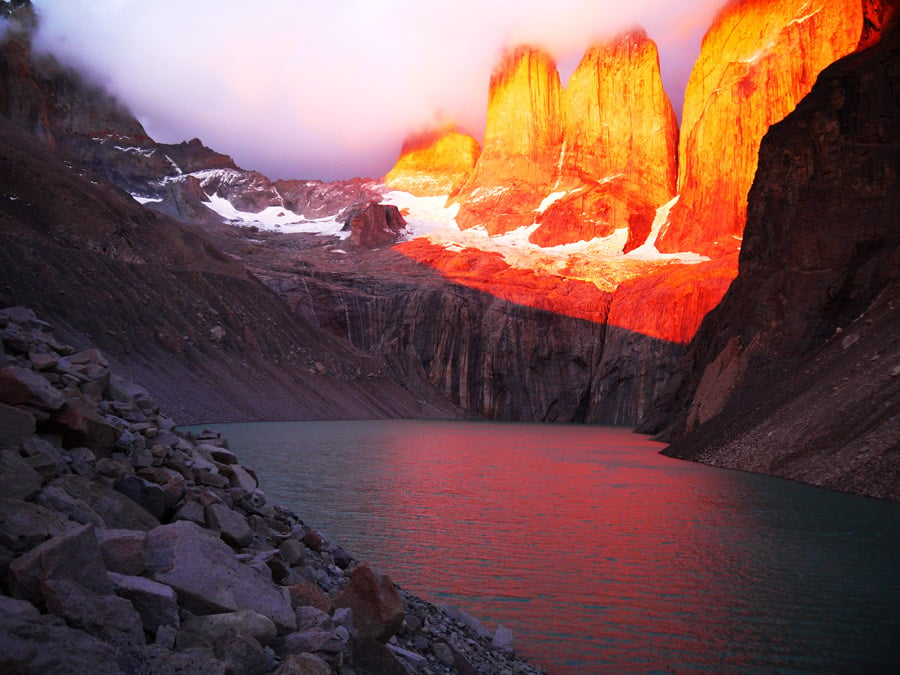
Best Season to Hike in Patagonia
In Summer, January to March is peak season to visit Patagonia. This is probably the best weather, but unfortunately, also the highest prices and the trails are very busy. In the shoulder season October/November or March/April you can still get good weather, better prices and more space on the trails. This is a better time for traveling on a budget. Regardless of when you go, make sure you pack appropriately.
Torres Del Paine is an unreal hike, if you are limited on time you will see amazing scenery hiking the W-route, but don’t be scared of doing the O-route! You won’t regret it. Don’t let being on a tight budget stop you! What Will says is so true! You can hike these incredible routes with little money and you will see the same sites as hiking in an organised group.
Check out this post for info on the best time to visit Patagonia.
For more info on hiking in Torres Del Paine, check out this post.
Buy Us a Coffee!
A couple of you lovely readers suggested we set up a tip jar for direct support as an alternative to booking through our links, since we’ve decided to keep the site ad-free. So here it is!
You can now buy The Broke Backpacker a coffee. If you like and use our content to plan your trips, it’s a much appreciated way to show appreciation 🙂



